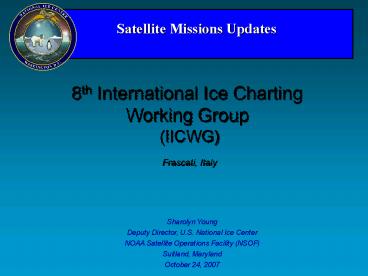Satellite Missions Updates - PowerPoint PPT Presentation
1 / 10
Title:
Satellite Missions Updates
Description:
National Polar-Orbiting Operational Environmental Satellite ... Visible Infrared Imaging Radiometer Suite (VIIRS) Reduced. Coverage (No mid-morning orbit) ... – PowerPoint PPT presentation
Number of Views:49
Avg rating:3.0/5.0
Title: Satellite Missions Updates
1
Satellite Missions Updates
8th International Ice Charting Working Group
(IICWG) Frascati, Italy
Sharolyn Young Deputy Director, U.S. National Ice
Center NOAA Satellite Operations Facility
(NSOF) Suitland, Maryland October 24, 2007
2
National Polar-Orbiting Operational Environmental
Satellite System (NPOESS ) Mission Update
3
National Polar-Orbiting Operational
Environmental Satellite System (NPOESS ) Mission
Update (cont)
4
Continuity of Polar Operational
Satellite Programs
5
NPOESS Sensor Updates
- Visible Infrared Imaging Radiometer Suite
(VIIRS) Reduced Coverage (No mid-morning
orbit) - Conical Scanning Microwave Imager (CMIS)
Reduced Capability - Capability and Coverage Reductions in Science
Priority
6
VIIRS NPOESS Mitigation
- VIIRS is intended to succeed the MODIS
instruments on Aqua and Terra - VIIRS was planned to fly on all six of the
original NPOESS missions - The Certified NPOESS uses an AVHRR on the
European MetOp Mission in the mid-AM orbit. - A VIIRS in the mid-AM orbit would continue the
climate data products presently produced by MODIS
on Terra
7
Conical Microwave Imaging Scanner (CMIS)(Reduced
Capability Sensor)
- Provides sea surface temperatures, sea ice and
snow cover extents - Ability to obtain both day and night measurements
- CMIS data are currently provided by the Aqua
AMSR-E instrument, the SeaWinds scatterometer on
the QuikSCATMission, and the experimental surface
vector wind sensor from the Navys
Windsat/Coriolis Mission - Some of these data also provided by SSMIS on DMSP
Missions - CMIS was originally a six-band system with
vertical and horizontal polarization in each band - Descoped to a less expensive system known as
Microwave Imager/Sounder (MIS) - MIS not yet clearly defined in detail
- Scheduled for NPOESS C2 (2016)
8
Integrated Earth Observing Satellite Missions
9
Implementation of Planned Earth Observing
Systems
Phases 1 2007-2009 End of legacy and ongoing
satellite missions and instruments of significant
relevance to cryosphere monitoring . 2
2010-2015 Plans concepts for ample global
space observing systems for cryospheric
monitoring becoming reality, but at considerable
cost. 3 After 2015 Optimistically
continued implementation of planned recommended
space missions that will fill key observational
gaps.
10
Thank You

